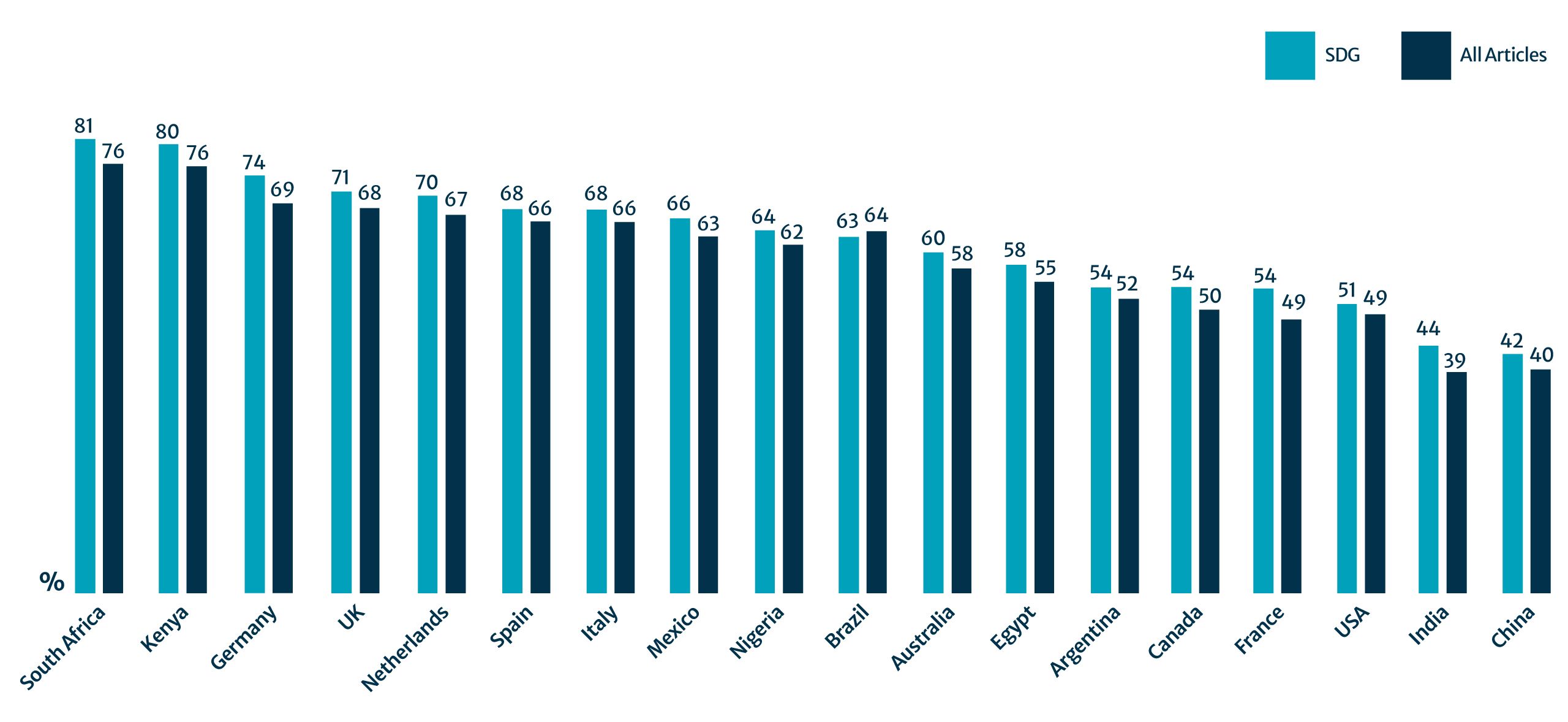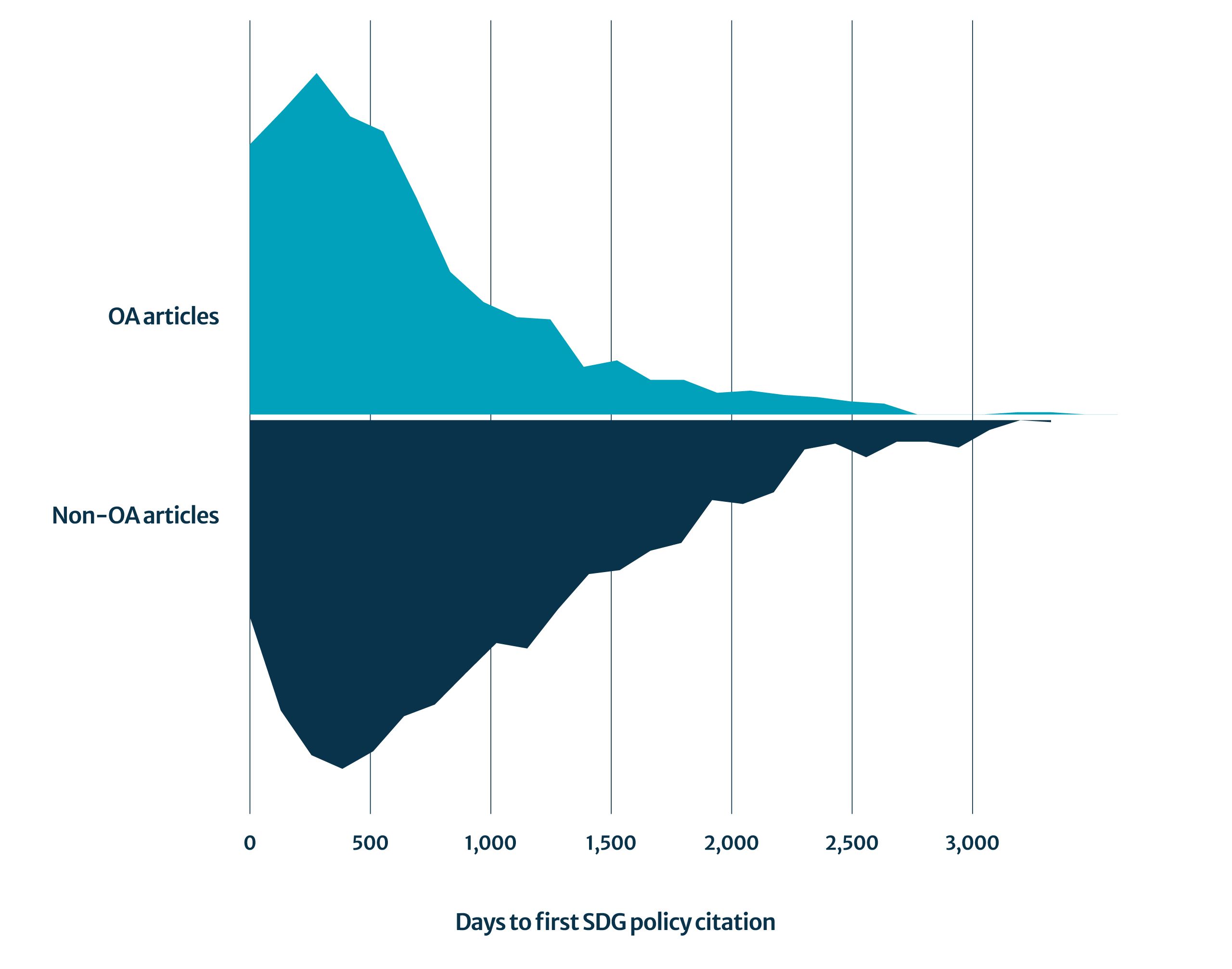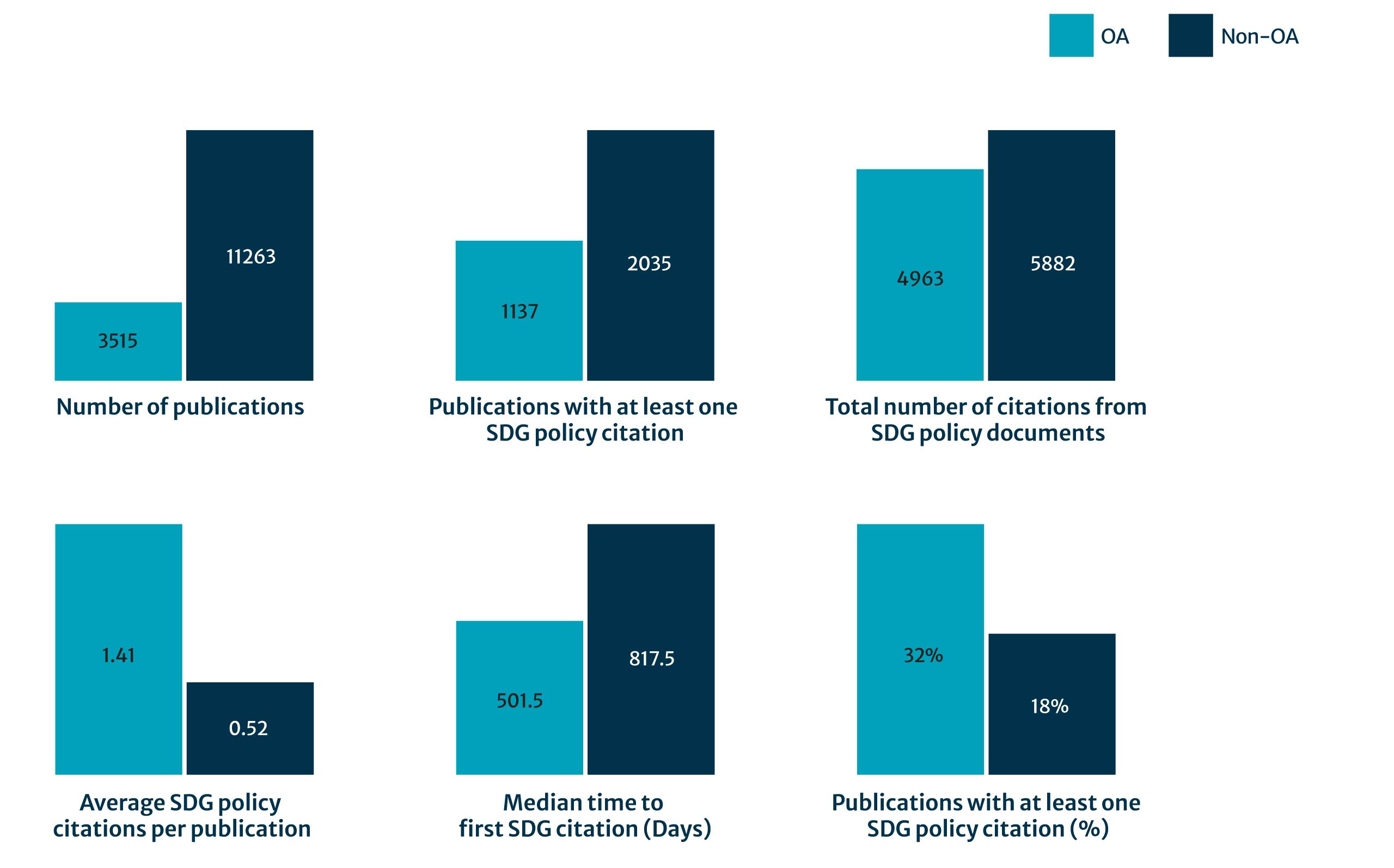How publishing models influence SDG impact

3.1 The use of open access (OA) research in SDG policy
OA supports the ambitions of the UN 2030 Agenda by ensuring that knowledge essential to sustainable development is accessible, reusable, and actionable.xv OA removes barriers to knowledge, increasing visibility and supporting global engagement. This is particularly important in LMICs, where access to research can be limited. Making research OA promotes global problem-solving, ensuring no one is left behind.xvi
SDG-related research is more likely to be published OA
OA research has grown steadily as a share of SDG-related publications, matching the pace of increased publishing related to the SDGs. SDG-related articles are more likely to be published OA than non-SDG articles (Fig. 13), reflecting a strong alignment between open dissemination and global development priorities. In 2024, 58% of all Springer Nature’s SDG articles were published OA, compared to 51% of all articles.
Figure 13: Percentage of 2024 SDG articles published OA (Gold or Hybrid OA) by country5
5 Source: Dimensions, SN Insights
Percentage of 2024 SDG articles published OA (Gold or Hybrid OA) by country
|
Country |
SDG % |
all articles % |
|---|---|---|
|
South Africa |
81 |
76 |
|
Kenya |
80 |
76 |
|
Germany |
74 |
69 |
|
UK |
71 |
68 |
|
Netherlands |
70 |
67 |
|
Spain |
68 |
66 |
|
Italy |
68 |
66 |
|
Mexico |
66 |
63 |
|
Nigeria |
64 |
62 |
|
Brazil |
63 |
64 |
|
Australia |
60 |
58 |
|
Egypt |
58 |
55 |
|
Argentina |
54 |
52 |
|
Canada |
54 |
50 |
|
France |
54 |
49 |
|
USA |
51 |
49 |
|
India |
44 |
39 |
|
China |
42 |
40 |
Policy impact from OA SDG research varies by region
Patterns of how OA research is used in policy highlight a North-to-South divide (Fig. 14). We used OpenAlex data to map the OA status of all scholarly research cited by SDG-related policy in the set. In Argentina, Brazil, Kenya, Nigeria, and South Africa, OA research makes up over 55–60% of the research cited in SDG-related policy. South Africa stands out with the highest percentage of OA research cited in SDG-related policies (over 60%).
In contrast, Australia, Canada, China and the USA are among countries where non-OA research makes up over 50% of citations. This imbalance in OA research policy citations reinforces known access gaps: while access barriers remain a challenge in the Global South, higher-income countries cite a broader mix of sources.
Figure 14: Percentage of policy citations by publication model (OA vs non-OA)
This figure shows the share of citations in SDG-related policy documents (published 2015–2025) to research articles, split by access type (OA vs non-OA). Policy source country is the country of the institution publishing the citing policy document. Article access status is taken from OpenAlex open access metadata. Percentages are calculated within each country, relative to all distinct DOIs cited by that country’s SDG-related policy documents.
Percentage of policy citations by publication model (OA vs non-OA)
|
Policy source country |
Open Access |
Non-Open Access |
|---|---|---|
|
South Africa |
61 |
39 |
|
Nigeria |
57 |
43 |
|
Argentina |
57 |
43 |
|
Kenya |
57 |
43 |
|
Brazil |
56 |
44 |
|
Spain |
54 |
46 |
|
Italy |
53 |
47 |
|
UK |
52 |
48 |
|
Germany |
51 |
49 |
|
Netherlands |
51 |
49 |
|
Mexico |
50 |
50 |
|
France |
50 |
50 |
|
USA |
49 |
51 |
|
Egypt |
49 |
51 |
|
Canada |
48 |
52 |
|
India |
47 |
53 |
|
Australia |
45 |
55 |
|
China |
41 |
59 |
OA research reaches policy faster
Using a sample of 11 Springer hybrid journals, we compared OA and non-OA citations in SDG-related policy from 2015 to 2024.6 Hybrid journals offer a way to compare similar articles based on their field, selectivity, and potential impact, regardless of business model. In total, there were 14,778 publications, of which 11,263 (76%) were non-OA and 3,515 (24%) were OA. Across the sample, OA publications were cited in SDG-related policy sooner, with a shorter median time to first citation (501 days), compared to 817 days for non-OA articles (Fig. 16).
Figure 15: Time to first policy citation by access type
This figure compares the number of days it takes OA versus non-OA articles to be cited in a policy document for the first time.
6 The Journal of Economic Inequality; Agronomy for Sustainable Development; Ambio; Food Security; Environmental and Resource Economics; Ecosystems; Agroforestry Systems; Environmental Management; European Journal of Clinical Nutrition; Social Indicators Research; Natural Hazards.
Time to first policy citation by access type
|
Days to first SDG policy citation |
Number of OA articles |
Number of non-OA articles |
|---|---|---|
|
0–124 |
125 |
101 |
|
125–249 |
141 |
149 |
|
250–374 |
158 |
172 |
|
375–499 |
138 |
179 |
|
500–624 |
131 |
170 |
|
625–749 |
100 |
152 |
|
750–874 |
66 |
146 |
|
875–999 |
52 |
130 |
|
1000–1124 |
45 |
110 |
|
1125–1249 |
44 |
126 |
|
1250–1374 |
22 |
97 |
|
1375–1499 |
25 |
79 |
|
1500–1624 |
16 |
77 |
|
1625–1749 |
16 |
67 |
|
1750–1874 |
10 |
63 |
|
1875–1999 |
11 |
41 |
|
2000–2124 |
9 |
43 |
|
2125–2249 |
8 |
37 |
|
2250–2374 |
6 |
15 |
|
2375–2499 |
5 |
12 |
|
2500–2624 |
0 |
19 |
|
2625–2749 |
0 |
11 |
|
2750–2874 |
0 |
11 |
|
2875–2999 |
1 |
14 |
|
3000–3124 |
1 |
5 |
|
3125–3249 |
0 |
0 |
|
3250–3375 |
0 |
1 |
OA is more frequently cited, with a higher average number of policy citations
For the same sample of articles, OA articles were more likely to receive at least one policy citation and also receive a higher average number of citations per article compared with non-OA articles (Fig. 16). However, the distribution is highly skewed: most articles receive no citations at all, while a small number receive a large volume, suggesting a long-tail pattern of policy influence.
Figure 16: Articles from the selected Springer hybrid journals by access type (OA vs non-OA) and policy citations
This figure summarises Springer Nature hybrid journal articles published in 2015 or later, split by access type (OA vs non-OA). Metrics are calculated at the publication (DOI) level. Results include: the total number of publications in each group; the number and percentage of publications that received at least one citation in an SDG-related policy document; the total number of such citations; the average number of SDG-related policy citations per publication; and the median time (in days) to first citation in an SDG-related policy document.
Articles from the selected Springer hybrid journals by access type (OA vs non-OA) and policy citations
|
Open Access |
Non-Open Access |
|
|---|---|---|
|
Number of publications |
3515 |
11263 |
|
Publications with at least one SDG policy citation (#) |
1137 |
2035 |
|
Total number of citations from SDG policy documents |
4963 |
5882 |
|
Average SDG policy citations per publication |
1.41 |
0.52 |
|
Median time to first SDG citation |
501.5 |
817.5 |
|
Publications with at least one SDG policy citation (%) |
32 |
18 |
Our findings indicate that the visibility and reach of SDG research in policy are amplified when published OA. However, higher citations for OA could be influenced by a variety of factors, including funder mandates, institutional support, and author intent.xvii In addition, the national differences in research publishing and policy practices highlighted in this report may also shape the likelihood and timing of policy citations.
3.2. Inclusive journals can be as impactful as selective journals in SDG policy
Inclusive journals (publishing technically sound research rather than prioritising selectivity) play a critical role in advancing the Goals. Often OA, broader in authorship and interdisciplinary in scope, they widen participation in global research. This aligns closely with the aims of the SDGs. But how do they perform when it comes to influencing policy?
We compared a sample of 100,000 articles from Springer Nature’s inclusive OA journals to a matched sample from selective OA journals, controlling for topic, publication year, and article type. The analysis was repeated 1,000 times using different random comparator sets (Fig. 17).
Figure 17: Citations of inclusive and selective sample (n=100,000) in SDG-related policy
We took a sample of 100K inclusive journal articles. For each article in the sample, we picked a comparator from a SN selective journal with the sample topic field, year, and publication type. We then looked at the percentage of DOIs which were cited in policy for the inclusive and selective sample. We did this 1,000 times to get 1,000 different comparator sets. This figure shows the summary statistics for the comparator sets and the inclusive sample, as outlined above.
Articles from the selected Springer hybrid journals by access type (OA vs non-OA) and policy citations
|
Inclusive |
Selective (median of paired samples) |
|
|---|---|---|
|
Percentage of publications with policy citations |
5.75 |
5.50 |
Overall, the inclusive journal articles were slightly more likely to be cited in SDG policy than those from selective journals. This is a notable finding, as it suggests that while some selective journals may be more highly cited in academia than inclusive journals, they are not necessarily more influential in policy.xviii By broadening access and authorship, inclusive journals may offer a more direct route to real-world impact, especially for research aligned with the SDGs.
Among inclusive journals, the BMC series (e.g. BMC Public Health and BMC Medical Ethics) stand out as the most frequently cited in SDG-related policy, both in terms of the number of citations and the number of articles cited.
3.3. The use of non-primary research in SDG policy
Non-primary content types offer a route to build broader engagement with academic content. Review articles, for example, offer a more balanced and comprehensive overview of a development in a field, while letters and comments offer a short format for feedback. News and editorials help highlight the meaning of a particular finding to a general audience beyond a journal’s specialised community. To assess how these non-primary research articles perform in policy impact, we looked at how different content types in the Nature Portfolio Research journals were cited in policy, comparing policy citations against traditional academic citations.7
Informal content types have policy impact
While original research makes up most academic citations, reviews, letters, and news are highly cited in both SDG and non-SDG related policy, despite these being a smaller share of total publications (Fig. 18). This reinforces that policy engagement isn’t limited to original research; there is value in less formal or contextual article types that summarise and synthesise research for time-pressured policymakers.
Figure 18: Percentage of academic and policy citations for Nature Research articles by article type
7 List of journals: Nature; Nature Aging; Nature Astronomy; Nature Biomedical Engineering; Nature Biotechnology; Nature Cancer; Nature Cardiovascular Research; Nature Catalysis; Nature Cell Biology; Nature Chemical Biology; Nature Chemical Engineering; Nature Chemistry; Nature Cities; Nature Climate Change; Nature Communications; Nature Computational Science; Nature Ecology & Evolution; Nature Electronics; Nature Energy; Nature Food; Nature Genetics; Nature Geoscience; Nature Human Behaviour; Nature Immunology; Nature Machine Intelligence; Nature Materials; Nature Medicine; Nature Mental Health; Nature Metabolism; Nature Microbiology; Nature Nanotechnology; Nature Neuroscience; Nature Photonics; Nature Physics; Nature Plants; Nature Structural & Molecular Biology; Nature Sustainability; Nature Synthesis; Nature Water. Academic citations counted using Web of Science data.
Percentage of academic and policy citations for Nature Research articles by article type
|
Citation category |
Policy |
SDG Policy |
Web of Science |
|---|---|---|---|
|
Book Review |
2 |
1 |
19 |
|
News |
9 |
7 |
31 |
|
Interview |
4 |
4 |
33 |
|
Editorial Notes |
6 |
5 |
38 |
|
Brief Communication |
1 |
1 |
50 |
|
Erratum |
6 |
6 |
53 |
|
Report |
2 |
2 |
63 |
|
Letter |
16 |
15 |
81 |
|
Review Paper |
30 |
27 |
94 |
|
Original Paper |
10 |
9 |
96 |
xv United Nations. (2015). Transforming our world: The 2030 Agenda for Sustainable Development. https://sdgs.un.org/2030agenda
xvi Springer Nature. (2025, July 31). Springer Nature’s 2024 Open Access (OA) report highlights growing value for authors. https://group.springernature.com/gp/group/media/press-releases/fourth-annual-oa-report-highlights-growing-value-for-authors/27799766
xvii Piwowar, H., Priem, J., Larivière, V., Alperin, J. P., Matthias, L., Norlander, B., Farley, A., West, J., & Haustein, S. (2018). The state of OA: A large-scale analysis of the prevalence and impact of Open Access articles. PeerJ, 6, e4375. https://doi.org/10.7717/peerj.4375
xviii Gill-Bains, G. (2025, June 19). Redefining impact: How inclusive publishing builds value beyond journal rankings. The Researcher’s Source. https://www.springernature.com/gp/researchers/the-source/blog/blogposts-for-editors/inclusive-publishing-builds-value/27787746






















